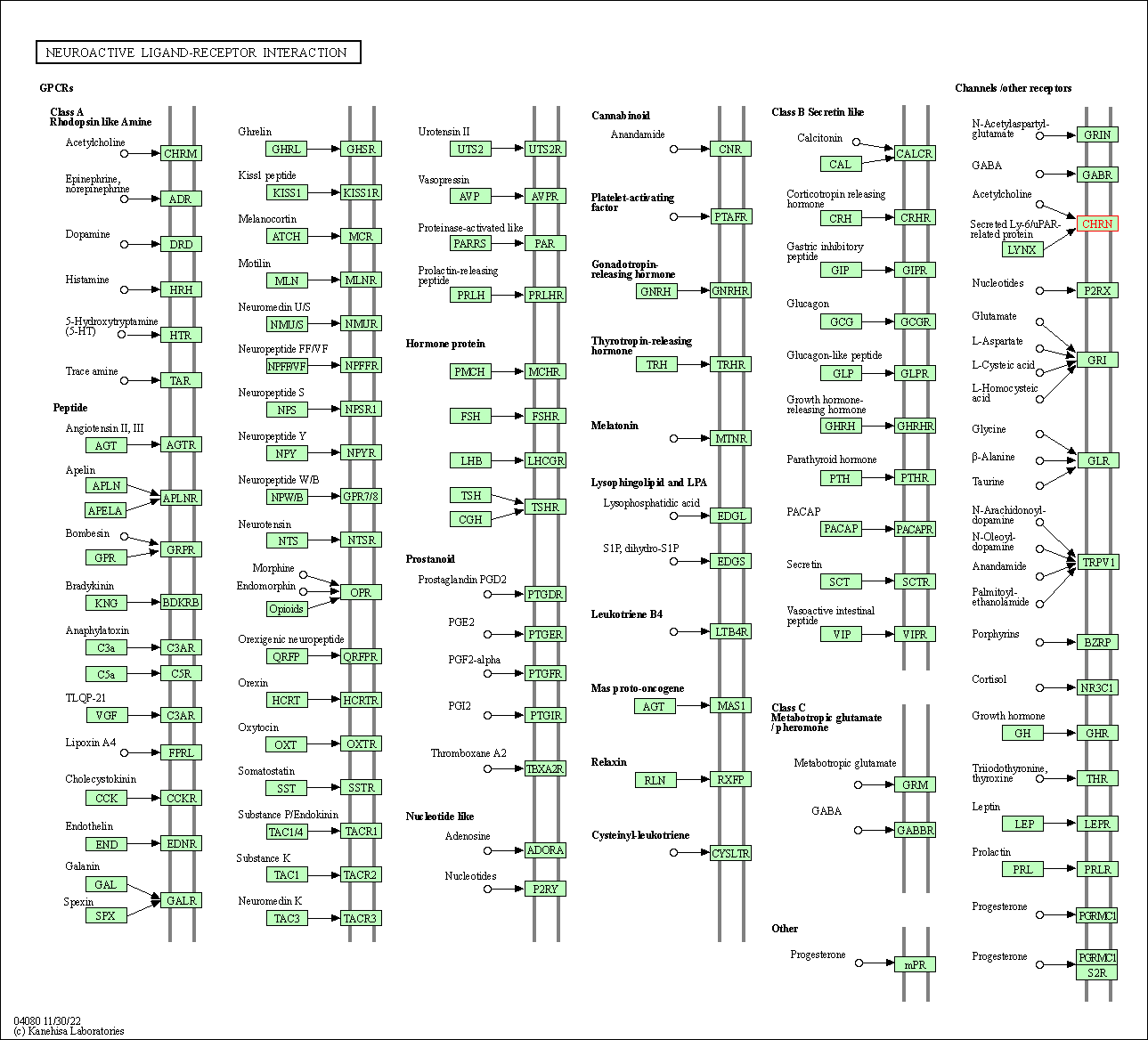Target Information
| Target General Information | Top | |||||
|---|---|---|---|---|---|---|
| Target ID |
T13795
(Former ID: TTDC00239)
|
|||||
| Target Name |
Neuronal acetylcholine receptor alpha-9 (CHRNA9)
|
|||||
| Synonyms |
Nicotinic acetylcholine receptor subunit alpha 9; NACHR alpha 9; CHRNA9
Click to Show/Hide
|
|||||
| Gene Name |
CHRNA9
|
|||||
| Target Type |
Literature-reported target
|
[1] | ||||
| Function |
Ionotropic receptor with a probable role in the modulation of auditory stimuli. Agonist binding induces a conformation change that leads to the opening of an ion-conducting channel across the plasma membrane (PubMed:11752216, PubMed:25282151). The channel is permeable to a range of divalent cations including calcium, the influx of which may activate a potassium current which hyperpolarizes the cell membrane (PubMed:11752216, PubMed:25282151). In the ear, this may lead to a reduction in basilar membrane motion, altering the activity of auditory nerve fibers and reducing the range of dynamic hearing. This may protect against acoustic trauma. May also regulate keratinocyte adhesion (PubMed:11021840).
Click to Show/Hide
|
|||||
| BioChemical Class |
Neurotransmitter receptor
|
|||||
| UniProt ID | ||||||
| Sequence |
MNWSHSCISFCWIYFAASRLRAAETADGKYAQKLFNDLFEDYSNALRPVEDTDKVLNVTL
QITLSQIKDMDERNQILTAYLWIRQIWHDAYLTWDRDQYDGLDSIRIPSDLVWRPDIVLY NKADDESSEPVNTNVVLRYDGLITWDAPAITKSSCVVDVTYFPFDNQQCNLTFGSWTYNG NQVDIFNALDSGDLSDFIEDVEWEVHGMPAVKNVISYGCCSEPYPDVTFTLLLKRRSSFY IVNLLIPCVLISFLAPLSFYLPAASGEKVSLGVTILLAMTVFQLMVAEIMPASENVPLIG KYYIATMALITASTALTIMVMNIHFCGAEARPVPHWARVVILKYMSRVLFVYDVGESCLS PHHSRERDHLTKVYSKLPESNLKAARNKDLSRKKDMNKRLKNDLGCQGKNPQEAESYCAQ YKVLTRNIEYIAKCLKDHKATNSKGSEWKKVAKVIDRFFMWIFFIMVFVMTILIIARAD Click to Show/Hide
|
|||||
| 3D Structure | Click to Show 3D Structure of This Target | AlphaFold | ||||
| HIT2.0 ID | T68J1I | |||||
| Cell-based Target Expression Variations | Top | |||||
|---|---|---|---|---|---|---|
| Cell-based Target Expression Variations | ||||||
| Drug Binding Sites of Target | Top | |||||
|---|---|---|---|---|---|---|
| Ligand Name: [3H]methyllycaconitine | Ligand Info | |||||
| Structure Description | Crystal Structure of the Extracellular Domain of the Human Alpha9 Nicotinic Acetylcholine Receptor In Complex with Methyllycaconitine | PDB:4UXU | ||||
| Method | X-ray diffraction | Resolution | 1.71 Å | Mutation | No | [2] |
| PDB Sequence |
GKYAQKLFND
12 LFEDYSNALR22 PVEDTDKVLN32 VTLQITLSQI42 KDMDERNQIL52 TAYLWIRQIW 62 HDAYLTWDRD72 QYDGLDSIRI82 PSDLVWRPDI92 VLYNKADDES102 SEPVNTNVVL 112 RYDGLITWDA122 PAITKSSCVV132 DVTYFPFDNQ142 QCNLTFGSWT152 YNGNQVDIFN 162 ALDSGDLSDF172 IEDVEWEVHG182 MPAVKNVISY192 GCCSEPYPDV202 TFTLLLKRRS 212
|
|||||
|
|
||||||
| Click to View More Binding Site Information of This Target with Different Ligands | ||||||
| Different Human System Profiles of Target | Top |
|---|---|
|
Human Similarity Proteins
of target is determined by comparing the sequence similarity of all human proteins with the target based on BLAST. The similarity proteins for a target are defined as the proteins with E-value < 0.005 and outside the protein families of the target.
A target that has fewer human similarity proteins outside its family is commonly regarded to possess a greater capacity to avoid undesired interactions and thus increase the possibility of finding successful drugs
(Brief Bioinform, 21: 649-662, 2020).
Human Pathway Affiliation
of target is determined by the life-essential pathways provided on KEGG database. The target-affiliated pathways were defined based on the following two criteria (a) the pathways of the studied target should be life-essential for both healthy individuals and patients, and (b) the studied target should occupy an upstream position in the pathways and therefore had the ability to regulate biological function.
Targets involved in a fewer pathways have greater likelihood to be successfully developed, while those associated with more human pathways increase the chance of undesirable interferences with other human processes
(Pharmacol Rev, 58: 259-279, 2006).
Human Similarity Proteins
Human Pathway Affiliation
|
|
|
There is no similarity protein (E value < 0.005) for this target
|
| KEGG Pathway | Pathway ID | Affiliated Target | Pathway Map |
|---|---|---|---|
| Neuroactive ligand-receptor interaction | hsa04080 | Affiliated Target |

|
| Class: Environmental Information Processing => Signaling molecules and interaction | Pathway Hierarchy | ||
| Target Affiliated Biological Pathways | Top | |||||
|---|---|---|---|---|---|---|
| KEGG Pathway | [+] 1 KEGG Pathways | + | ||||
| 1 | Neuroactive ligand-receptor interaction | |||||
| Panther Pathway | [+] 1 Panther Pathways | + | ||||
| 1 | Nicotinic acetylcholine receptor signaling pathway | |||||
| Reactome | [+] 1 Reactome Pathways | + | ||||
| 1 | Highly calcium permeable postsynaptic nicotinic acetylcholine receptors | |||||
| WikiPathways | [+] 1 WikiPathways | + | ||||
| 1 | Neurotransmitter Receptor Binding And Downstream Transmission In The Postsynaptic Cell | |||||
| Target-Related Models and Studies | Top | |||||
|---|---|---|---|---|---|---|
| Target Validation | ||||||
| References | Top | |||||
|---|---|---|---|---|---|---|
| REF 1 | URL: http://www.guidetopharmacology.org Nucleic Acids Res. 2015 Oct 12. pii: gkv1037. The IUPHAR/BPS Guide to PHARMACOLOGY in 2016: towards curated quantitative interactions between 1300 protein targets and 6000 ligands. (Target id: 469). | |||||
| REF 2 | Crystal structures of free and antagonist-bound states of human Alpha9 nicotinic receptor extracellular domain. Nat Struct Mol Biol. 2014 Nov;21(11):976-80. | |||||
If You Find Any Error in Data or Bug in Web Service, Please Kindly Report It to Dr. Zhou and Dr. Zhang.

